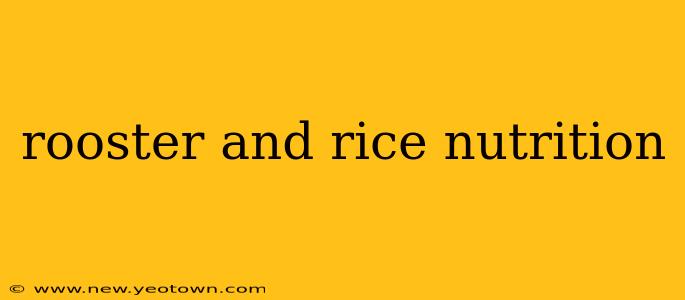Let's be honest, the combination of tender rooster meat and fluffy rice is comfort food at its finest. But beyond the delicious taste, what's the nutritional story behind this classic pairing? This isn't just about satisfying hunger; it's about understanding the nutritional benefits – and potential drawbacks – of this seemingly simple dish. We'll delve into the specifics of both rooster meat and rice, exploring their individual nutritional profiles and how they complement (or perhaps compete with) each other when served together.
What are the nutritional benefits of rooster meat?
Rooster meat, compared to chicken, often boasts a slightly tougher texture due to its older age. However, this doesn't diminish its nutritional value. Lean rooster meat is a fantastic source of high-quality protein, essential for building and repairing tissues, supporting immune function, and maintaining overall health. It's also a good source of several essential vitamins and minerals, including niacin, vitamin B6, selenium, and phosphorus. These nutrients contribute to various bodily functions, from energy production to healthy bone development.
Compared to younger chicken, rooster meat tends to have a slightly higher fat content, particularly if the rooster is older or has been raised on a diet richer in fat. However, this fat is predominantly unsaturated, which is beneficial for heart health when consumed in moderation. The fatty acids found in rooster meat can also contribute to satiety, keeping you feeling fuller for longer.
What are the nutritional benefits of rice?
Rice, a staple food across many cultures, is primarily a source of carbohydrates, providing the body with energy. However, the nutritional profile can vary significantly depending on the type of rice. Brown rice, for example, is a whole grain and contains more fiber, magnesium, and other nutrients compared to white rice, which has undergone more processing. Brown rice offers significant benefits for digestion and can help regulate blood sugar levels. White rice, while offering a quicker energy source, is lower in fiber and some essential vitamins and minerals.
The glycemic index (GI) of rice is also something to consider. White rice has a higher GI than brown rice, meaning it can cause a faster spike in blood sugar levels. For people with diabetes or those aiming to manage their blood sugar, brown rice is often the preferred choice. Additionally, enriched white rice often contains added folic acid and iron.
How does the combination of rooster and rice affect nutrition?
When rooster and rice are combined, you get a relatively balanced meal providing protein (from the rooster) and carbohydrates (from the rice). This makes it a satisfying and energy-providing combination. However, the overall nutritional value depends heavily on the preparation method. Dishes heavy in oil or sodium can negate some of the health benefits. For example, a stir-fry with excess oil will add unhealthy fats, while a dish with added salt may increase sodium intake, potentially raising blood pressure.
It's crucial to consider portion sizes. Overconsumption of both rooster and rice, especially white rice, can lead to weight gain due to the higher carbohydrate content.
Is rooster and rice a healthy meal?
Whether rooster and rice constitutes a "healthy" meal depends on several factors:
- Type of rice: Brown rice is a healthier choice than white rice due to its higher fiber and nutrient content.
- Preparation method: Steaming or baking is healthier than frying. Minimizing added oils, salt, and sauces enhances the nutritional value.
- Portion size: Maintaining appropriate portion sizes is crucial for preventing overconsumption of carbohydrates and fats.
- Accompanying ingredients: Adding vegetables to the dish increases its nutritional profile significantly, providing added vitamins, minerals, and fiber.
What are some healthier ways to prepare rooster and rice?
To maximize the nutritional benefits of rooster and rice, opt for these preparation methods:
- Roast the rooster: Roasting allows for healthier fat rendering and preserves the flavor of the meat.
- Use brown rice: This offers more fiber and nutrients compared to white rice.
- Add vegetables: Incorporate plenty of colorful vegetables like broccoli, carrots, and peppers to boost the vitamin and mineral content.
- Use herbs and spices: Flavor the dish with herbs and spices instead of relying heavily on salt or sauces.
- Control portion sizes: Be mindful of the amount of rooster and rice you consume.
Are there any potential drawbacks to eating rooster and rice?
While generally a nutritious combination, excessive consumption of rice, especially white rice, can contribute to weight gain and blood sugar spikes. Similarly, overconsumption of rooster meat, especially if prepared with excessive fat, can increase cholesterol levels. Always focus on moderation and a balanced diet.
By understanding the nutritional profile of both rooster meat and rice and making smart choices regarding preparation and portion sizes, you can enjoy this classic dish while maximizing its health benefits. Remember, balance is key to a healthy and delicious eating experience.

